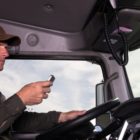Aside from providing superior customer service, one of the most crucial considerations for a flourishing business is saving money. The more money you save, the more money you have to help your business expand and grow. While installing video cameras in your fleet vehicles may not be the first money saving technique that comes to mind, it certainly should not be the last. The following are five ways your transportation business can save money by using videomatics technology in your fleet.
Driver Monitoring
In general, humans tend to behave better when they know they are being watched. Whether succumbing to social structures or attempting to impress their peers, people have a habit of monitoring their behavior to fulfill cultural expectations. By adding a camera to your vehicles, you aim to improve driver behavior regarding accountability, making employees drive safer and lowering the risk of accidents. With fewer accidents, your company will pay less in damaged vehicle repair, and less in coverage costs for injured drivers.
Video data collection can also show which of your employees may need additional training, another common aspect of business management that pays off in well-trained employees in the long run. Consider offering incentives to employees that prove themselves capable of driving safely and delivering your products on time. For a functional and efficient business, remember to invest in videomatics to promote your company’s growth.
Fighting Fraud
In the transportation industry there is always the risk of fraud. If other motorists claim that your driver hit their car, or if they attempt a quick ‘crash and cash’ scheme by slamming on their brakes in front of your driver, you need access to technology that protects your business investments. Dash cameras can prove liability, allowing your drivers to demonstrate their innocence and maintain a clean driving record. Videomatics can be a digital witness to protect your drivers from wrongful punishment as well, allowing law enforcement officers to examine the circumstances of the crash, and assign fault accordingly. Cameras facing into the cab may also prove useful in protecting your drivers from wrongful accusations. An inward-facing camera can confirm what your driver was doing prior to and during the accident and show evidence regarding their role in the incident. In either case, access to definite proof can speed a case along.
Insurance Issues
Insurance companies are notoriously hard to work with after accidents and attempting to rush a claim rarely if ever works to anyone’s advantage. But imagine having video proof regarding the incident in question. With videomatics, insurance companies can process claims faster and manage related financial aspects fairly. Insurance companies are also concerned about saving money, so any safety equipment data that reveals money saving opportunities for insurance companies may bring out the coveted discounts.
GPS Tracking
When drivers are in the field, they typically have complete control over the use of company vehicles. By utilizing installed GPS and videomatics software, you can authenticate vehicle use claims regarding location and time spent on the road. Video collection can prove that vehicles are, and remain, where they are supposed to be. Say your data indicates that one particular vehicle uses more gas than the others along the same delivery route. With dash camera records, fleet managers can examine what may be causing the discrepancy. Perhaps the driver stops for coffee along the route while on the clock and idles in a drive-thru. With video evidence in hand, fleet managers can discourage use of company vehicles for personal errands and record and store evidence if vehicles are used inappropriately.
The Wonderful Opportunity of Section 179
Most people would agree that the IRS is not an enjoyable topic to discuss, especially in regards to business practices. However, in this instance the U.S. government and, by extension, the IRS, can actually work in your favor. Originally created as a means to encourage businesses to invest in their own future, Section 179 of the IRS Tax Code concerns tax deductions for purchases of certain qualified equipment. This means if you purchase or lease qualifying devices, you can write off the full purchase price from your gross income in the year’s taxes. This deduction incentive allows transportation companies to experiment with different technologies with little risk to their profit margins.
Investing in the latest technologies can allow your business to grow in efficiency and function. By assessing what your company truly needs to thrive, you can calculate your expenses for maximum productivity. What better way to do this than by utilizing telematics and videomatics technologies.



